Seat Ibiza ST 2016 Owner's manual
Manufacturer: SEAT, Model Year: 2016, Model line: Ibiza ST, Model: Seat Ibiza ST 2016Pages: 252, PDF Size: 5.56 MB
Page 141 of 252
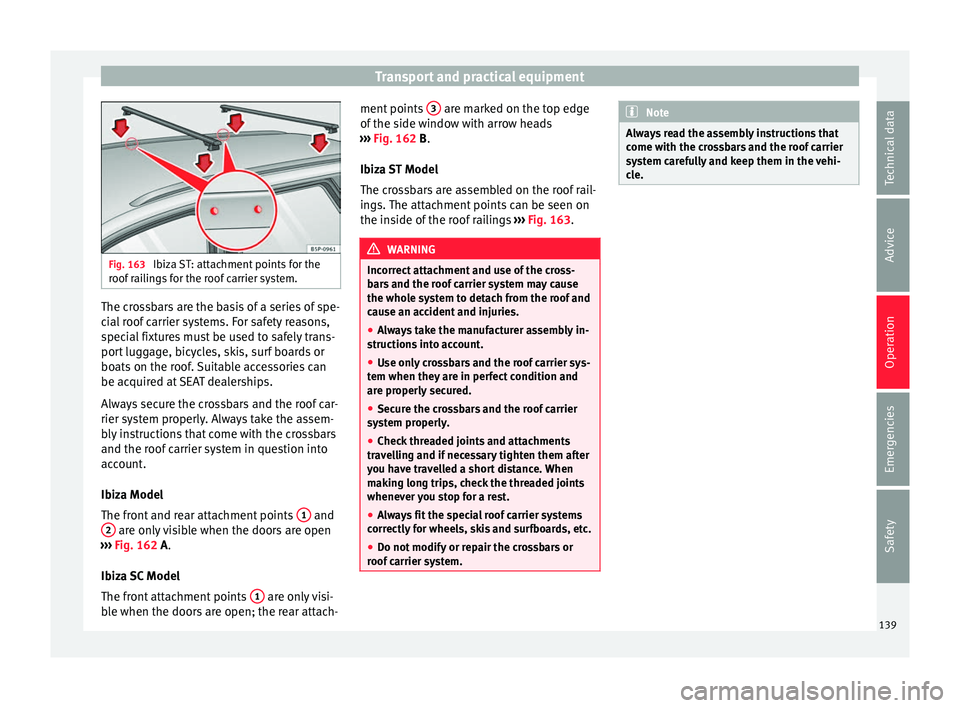
Transport and practical equipment
Fig. 163
Ibiza ST: attachment points for the
roof r ai
lings for the roof carrier system. The crossbars are the basis of a series of spe-
c
i
al r
oof carrier systems. For safety reasons,
special fixtures must be used to safely trans-
port luggage, bicycles, skis, surf boards or
boats on the roof. Suitable accessories can
be acquired at SEAT dealerships.
Always secure the crossbars and the roof car-
rier system properly. Always take the assem-
bly instructions that come with the crossbars
and the roof carrier system in question into
account.
Ibiza Model
The front and rear attachment points 1 and
2 are only visible when the doors are open
› ›
›
Fig. 162
A.
Ibiza SC Model
The front attachment points 1 are only visi-
b l
e when the door s
are open; the rear attach- ment points
3 are marked on the top edge
of the s
ide windo
w with arrow heads
››› Fig. 162 B.
Ibiza ST Model
The crossbars are assembled on the roof rail-
ings. The attachment points can be seen on
the inside of the roof railings ››› Fig. 163. WARNING
Incorrect attachment and use of the cross-
bars and the r
oof carrier system may cause
the whole system to detach from the roof and
cause an accident and injuries.
● Always take the manufacturer assembly in-
structions int
o account.
● Use only crossbars and the roof carrier sys-
tem when they are in per
fect condition and
are properly secured.
● Secure the crossbars and the roof carrier
system pr
operly.
● Check threaded joints and attachments
travellin
g and if necessary tighten them after
you have travelled a short distance. When
making long trips, check the threaded joints
whenever you stop for a rest.
● Always fit the special roof carrier systems
correctly f
or wheels, skis and surfboards, etc.
● Do not modify or repair the crossbars or
roof carrier sy
stem. Note
Always read the assembly instructions that
come with the c r
ossbars and the roof carrier
system carefully and keep them in the vehi-
cle. 139
Technical data
Advice
Operation
Emergencies
Safety
Page 142 of 252
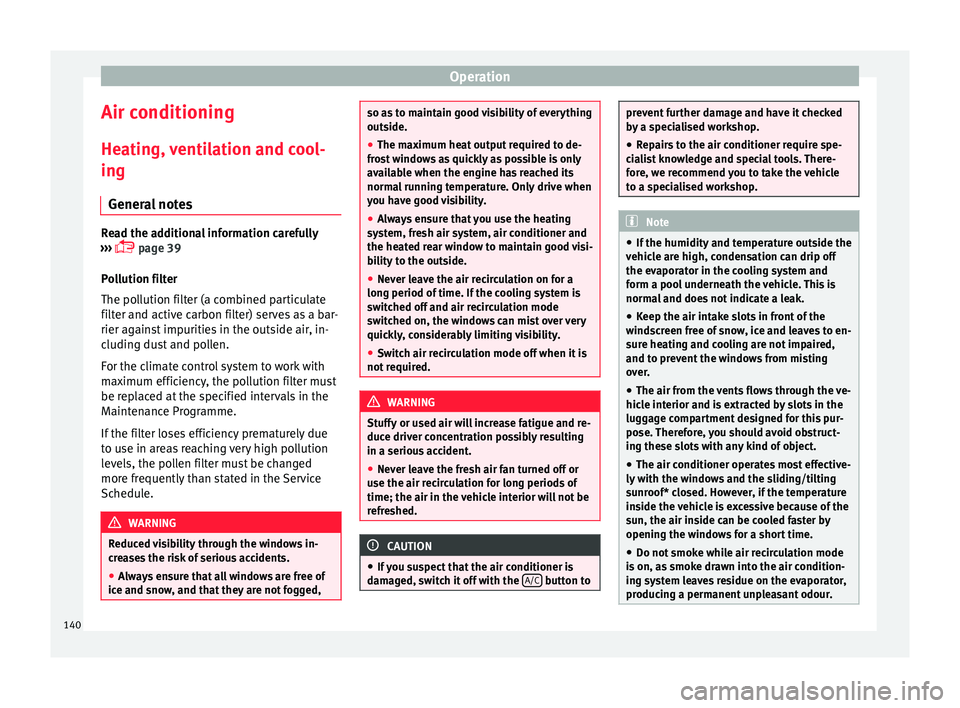
Operation
Air conditioning
He atin
g, v
entilation and cool-
ing
General notes Read the additional information carefully
›››
p
age 39
Pollution filter
The pollution filter (a combined particulate
filter and active carbon filter) serves as a bar-
rier against impurities in the outside air, in-
cluding dust and pollen.
For the climate control system to work with
maximum efficiency, the pollution filter must
be replaced at the specified intervals in the
Maintenance Programme.
If the filter loses efficiency prematurely due
to use in areas reaching very high pollution
levels, the pollen filter must be changed
more frequently than stated in the Service
Schedule. WARNING
Reduced visibility through the windows in-
cre a
ses the risk of serious accidents.
● Always ensure that all windows are free of
ice and snow
, and that they are not fogged, so as to maintain good visibility of everything
outside.
●
The m ax
imum heat output required to de-
frost
windows as quickly as possible is only
available when the engine has reached its
normal running temperature. Only drive when
you have good visibility.
● Always ensure that you use the heating
system, fr
esh air system, air conditioner and
the heated rear window to maintain good visi-
bility to the outside.
● Never leave the air recirculation on for a
long period of time. If the c
ooling system is
switched off and air recirculation mode
switched on, the windows can mist over very
quickly, considerably limiting visibility.
● Switch air recirculation mode off when it is
not required. WARNING
Stuffy or used air will increase fatigue and re-
duce driver c onc
entration possibly resulting
in a serious accident.
● Never leave the fresh air fan turned off or
use the air recir
culation for long periods of
time; the air in the vehicle interior will not be
refreshed. CAUTION
● If y ou s
uspect that the air conditioner is
damaged, switch it off with the A/C button to prevent further damage and have it checked
by a s
pec
ialised workshop.
● Repairs to the air conditioner require spe-
ciali
st knowledge and special tools. There-
fore, we recommend you to take the vehicle
to a specialised workshop. Note
● If the humidity and t emper
ature outside the
vehicle are high, condensation can drip off
the evaporator in the cooling system and
form a pool underneath the vehicle. This is
normal and does not indicate a leak.
● Keep the air intake slots in front of the
windsc
reen free of snow, ice and leaves to en-
sure heating and cooling are not impaired,
and to prevent the windows from misting
over.
● The air from the vents flows through the ve-
hicle interior and i
s extracted by slots in the
luggage compartment designed for this pur-
pose. Therefore, you should avoid obstruct-
ing these slots with any kind of object.
● The air conditioner operates most effective-
ly with the windo
ws and the sliding/tilting
sunroof* closed. However, if the temperature
inside the vehicle is excessive because of the
sun, the air inside can be cooled faster by
opening the windows for a short time.
● Do not smoke while air recirculation mode
is on, as
smoke drawn into the air condition-
ing system leaves residue on the evaporator,
producing a permanent unpleasant odour. 140
Page 143 of 252
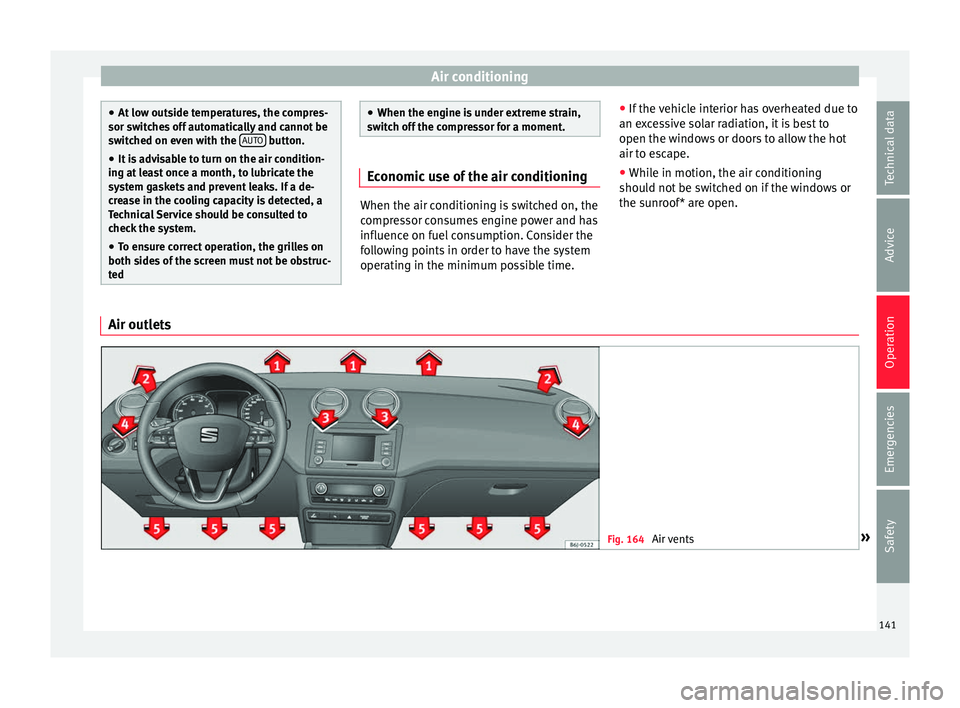
Air conditioning
●
At low out s
ide temperatures, the compres-
sor switches off automatically and cannot be
switched on even with the AUTO button.
● It is advisable to turn on the air condition-
ing at l e
ast once a month, to lubricate the
system gaskets and prevent leaks. If a de-
crease in the cooling capacity is detected, a
Technical Service should be consulted to
check the system.
● To ensure correct operation, the grilles on
both sides of
the screen must not be obstruc-
ted ●
When the engine is u
nder extreme strain,
switch off the compressor for a moment. Economic use of the air conditioning
When the air conditioning is switched on, the
compre
s
sor consumes engine power and has
influence on fuel consumption. Consider the
following points in order to have the system
operating in the minimum possible time. ●
If the v ehic
le interior has overheated due to
an excessive solar radiation, it is best to
open the windows or doors to allow the hot
air to escape.
● While in motion, the air conditioning
should not be sw
itched on if the windows or
the sunroof* are open.
Air outlets Fig. 164
Air vents » 141Technical data
Advice
Operation
Emergencies
Safety
Page 144 of 252
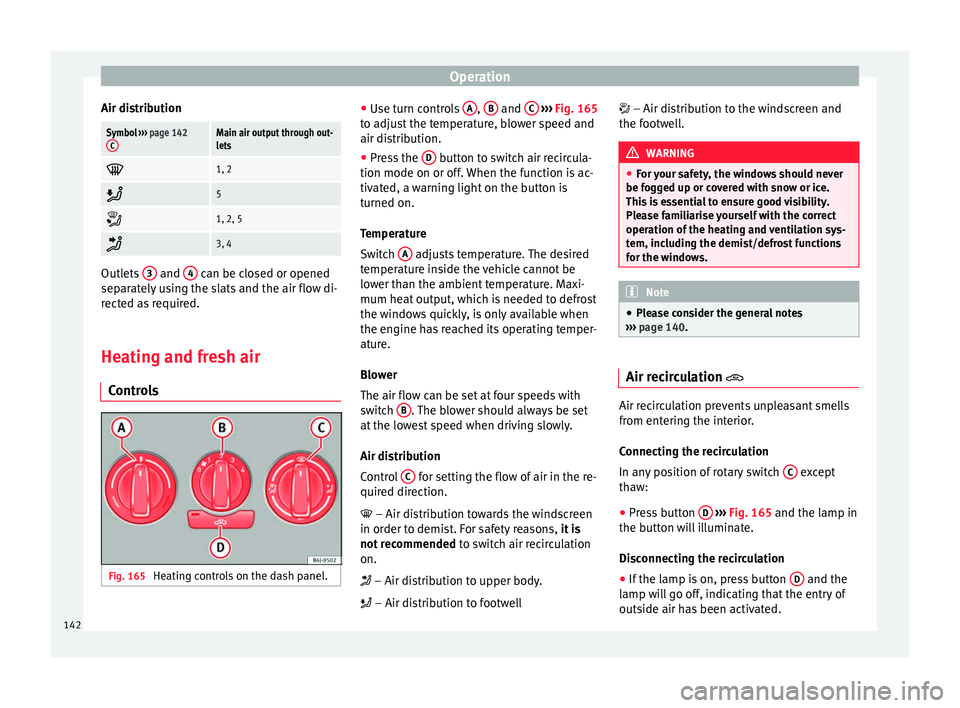
Operation
Air distributionSymbol ››› page 142
CMain air output through out-
lets
1, 2
5
1, 2, 5
3, 4
Outlets
3 and
4 can be closed or opened
separat ely
using the slats and the air flow di-
rected as required.
Heating and fresh air
Contro l
s Fig. 165
Heating controls on the dash panel. ●
Use t
urn c ontr
ols A ,
B and
C
› ››
Fig. 165
t o a dju
st the temperature, blower speed and
air distribution.
● Press the D button to switch air recircula-
tion mode on or off .
When the f u
nction is ac-
tivated, a warning light on the button is
turned on.
Temperature
Switch A adjusts temperature. The desired
t emper
atur
e inside the vehicle cannot be
lower than the ambient temperature. Maxi-
mum heat output, which is needed to defrost
the windows quickly, is only available when
the engine has reached its operating temper-
ature.
Blower
The air flow can be set at four speeds with
switch B . The blower should always be set
at the lo
we
st speed when driving slowly.
Air distribution
Control C for setting the flow of air in the re-
quir ed dir
ection.
– Air di
stribution towards the windscreen
in order to demist. For safety reasons, it is
not recommended to switch air recirculation
on.
– Air distribution to upper body.
– Air distribution to footwell – Air distribution to the windscreen and
the footwel
l. WARNING
● For y our s
afety, the windows should never
be fogged up or covered with snow or ice.
This is essential to ensure good visibility.
Please familiarise yourself with the correct
operation of the heating and ventilation sys-
tem, including the demist/defrost functions
for the windows. Note
● Plea se c
onsider the general notes
››› page 140. Air recirculation
Air recirculation prevents unpleasant smells
fr
om ent
ering the int
erior.
Connecting the recirculation
In any position of rotary switch C except
th a
w:
● Pr e
ss button D
› ›
›
Fig. 165
and the lamp in
the button will illuminate.
Disconnecting the recirculation
● If the lamp is on, press button D and the
l amp w
il
l go off, indicating that the entry of
outside air has been activated.
142
Page 145 of 252
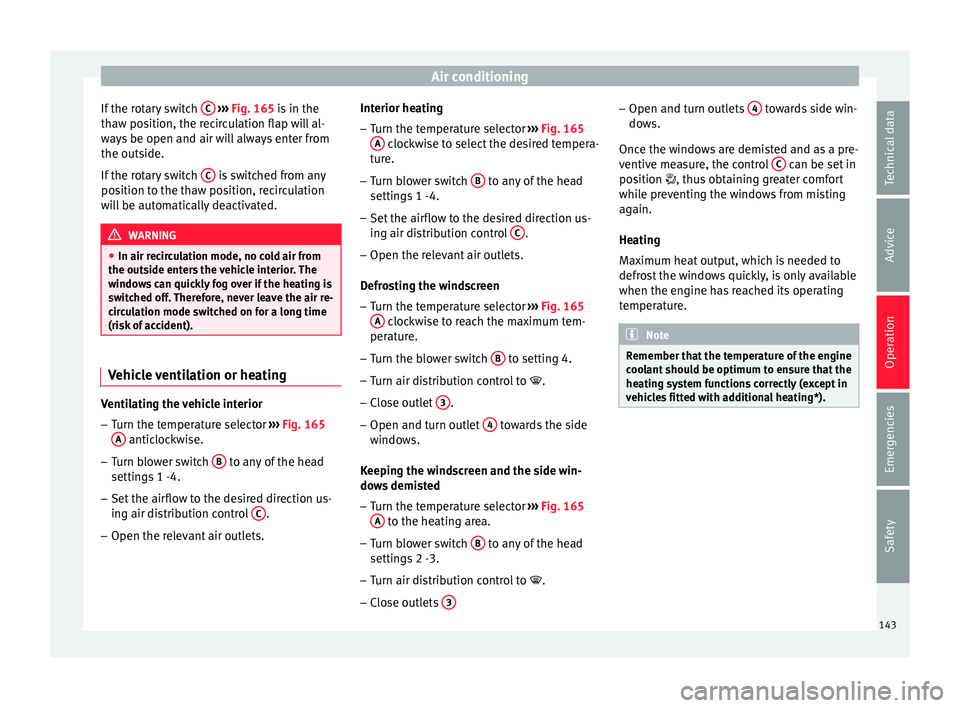
Air conditioning
If the rotary switch C
› ››
Fig. 165
is
in the
thaw position, the recirculation flap will al-
ways be open and air will always enter from
the outside.
If the rotary switch C is switched from any
po s
ition t o the th
aw position, recirculation
will be automatically deactivated. WARNING
● In air recir c
ulation mode, no cold air from
the outside enters the vehicle interior. The
windows can quickly fog over if the heating is
switched off. Therefore, never leave the air re-
circulation mode switched on for a long time
(risk of accident). Vehicle ventilation or heating
Ventilating the vehicle interior
– Turn the temperature selector ››
›
Fig. 165
A anticlockwise.
– Turn blower switch B to any of the head
settin g
s 1 -4.
– Set
the airflow to the desired direction us-
ing air distrib
ution control C .
– Open the relevant air outlets. Interior heating
– Turn the temperature selector ››
›
Fig. 165
A clockwise to select the desired tempera-
t ur
e.
– Turn b
lower switch B to any of the head
settin g
s 1 -4.
– Set
the airflow to the desired direction us-
ing air distrib
ution control C .
– Open the relevant air outlets.
D efr
os
ting the windscreen
– Turn the temperature selector ››› Fig. 165
A clockwise to reach the maximum tem-
per at
ur e.
– T
urn the blower switch B to setting 4.
– Turn air distribution control to .
– Close outlet 3 .
– Open and turn outlet 4 towards the side
w indo
ws.
K
eeping the windscreen and the side win-
dows demisted
– Turn the temperature selector ››› Fig. 165
A to the heating area.
– Turn blower switch B to any of the head
settin g
s 2 -3.
– T
urn air distribution control to .
– Close outlets 3 –
Open and t urn outl
ets 4 towards side win-
do w
s.
Onc e the w
indows are demisted and as a pre-
ventive measure, the control C can be set in
po s
ition
, thus obtaining greater comfort
while preventing the windows from misting
again.
Heating
Maximum heat output, which is needed to
defrost the windows quickly, is only available
when the engine has reached its operating
temperature. Note
Remember that the temperature of the engine
cool ant
should be optimum to ensure that the
heating system functions correctly (except in
vehicles fitted with additional heating*). 143
Technical data
Advice
Operation
Emergencies
Safety
Page 146 of 252
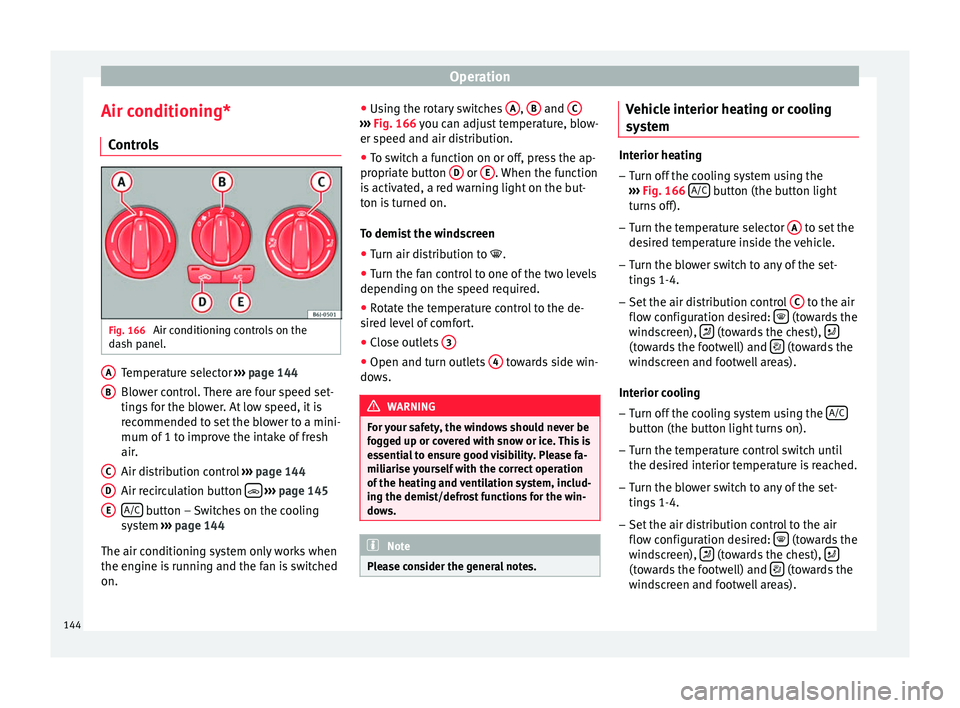
Operation
Air conditioning* C ontr
ol
s Fig. 166
Air conditioning controls on the
d a
sh p anel
. Temperature selector
››
›
p
age 144
Blower control. There are four speed set-
tings for the blower. At low speed, it is
recommended to set the blower to a mini-
mum of 1 to improve the intake of fresh
air.
Air distribution control ››› page 144
Air recirculation button
› ›
› p age 145
A/C button – Switches on the cooling
sy s
tem
›
›› page 144
The air conditioning system only works when
the engine is running and the fan is switched
on. A B
C
D
E ●
Us
in g the r
otary switches A ,
B and
C ›››
Fig. 166 y ou c
an a dju
st temperature, blow-
er speed and air distribution.
● To switch a function on or off, press the ap-
propriate b
utton D or
E . When the function
i s
activ at
ed, a red warning light on the but-
ton is turned on.
To demist the windscreen
● Turn air distribution to .
● Turn the fan control to one of the two levels
depending on the speed requir
ed.
● Rotate the temperature control to the de-
sired lev
el of comfort.
● Close outlets 3 ●
Open and turn outlets 4 towards side win-
do w
s. WARNING
For your safety, the windows should never be
fogg ed up or c
overed with snow or ice. This is
essential to ensure good visibility. Please fa-
miliarise yourself with the correct operation
of the heating and ventilation system, includ-
ing the demist/defrost functions for the win-
dows. Note
Please consider the general notes. Vehicle interior heating or cooling
sy
s
tem Interior heating
– Turn off the cooling system using the
››› Fig. 166
A/C button (the button light
turns off).
– T
urn the temperature selector A to set the
desir ed t
emperature inside the vehicle.
– Turn the blower switch to any of the set-
tings 1-4.
– Set
the air distribution control C to the air
flo w c
onfigur ation de
sired: (towards the
w ind
sc
reen), (towards the chest),
(towards the footwell) and
(towards the
w ind
sc
reen and footwell areas).
Interior cooling
– Turn off the cooling system using the A/C button (the button light turns on).
– Turn the temperature control switch until
the de s
ir ed int
erior temperature is reached.
– Turn the blower switch to any of the set-
tings 1-4.
– Set
the air distribution control to the air
flow configuration de
sired: (towards the
w ind
sc
reen), (towards the chest),
(towards the footwell) and
(towards the
w ind
sc
reen and footwell areas).
144
Page 147 of 252
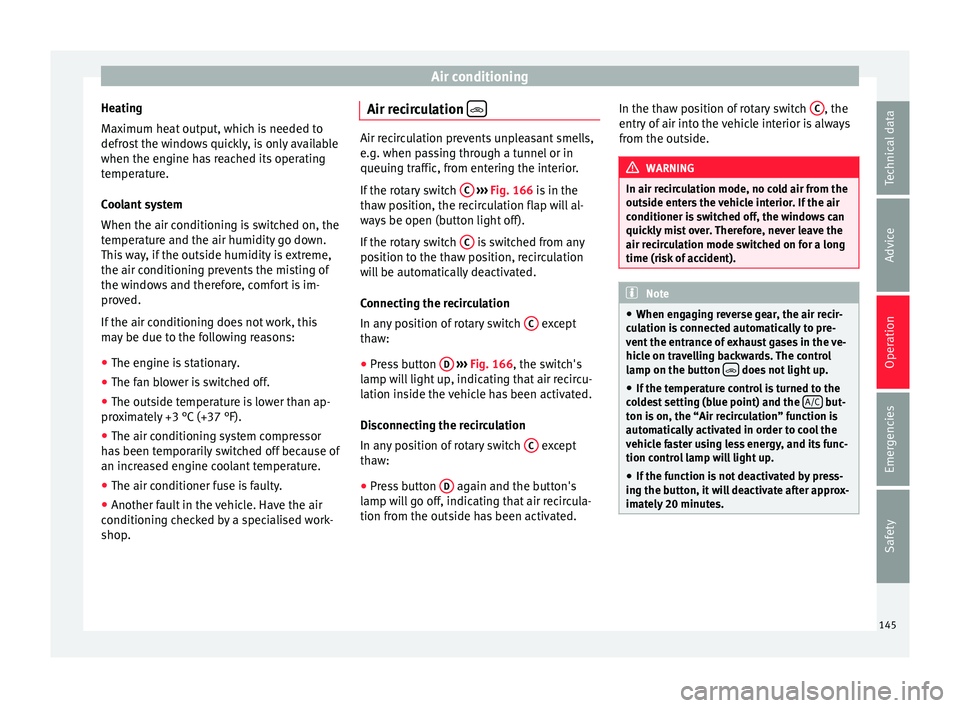
Air conditioning
Heating
M ax
imum he at
output, which is needed to
defrost the windows quickly, is only available
when the engine has reached its operating
temperature.
Coolant system
When the air conditioning is switched on, the
temperature and the air humidity go down.
This way, if the outside humidity is extreme,
the air conditioning prevents the misting of
the windows and therefore, comfort is im-
proved.
If the air conditioning does not work, this
may be due to the following reasons:
● The engine is stationary.
● The fan blower is switched off.
● The outside temperature is lower than ap-
proxim
ately +3 °C (+37 °F).
● The air conditioning system compressor
has been t
emporarily switched off because of
an increased engine coolant temperature.
● The air conditioner fuse is faulty.
● Another fault in the vehicle. Have the air
conditioning chec
ked by a specialised work-
shop. Air recirculation
Air recirculation prevents unpleasant smells,
e.g. when pa
s
sing through a tunnel or in
queuing traffic, from entering the interior.
If the rotary switch C
››› Fig. 166 i s
in the
thaw position, the recirculation flap will al-
ways be open (button light off).
If the rotary switch C is switched from any
position t o the th
aw position, recirculation
will be automatically deactivated.
Connecting the recirculation
In any position of rotary switch C except
th a
w:
● Pr e
ss button D
› ›
› Fig. 166 , the sw
itch's
lamp will light up, indicating that air recircu-
lation inside the vehicle has been activated.
Disconnecting the recirculation
In any position of rotary switch C except
th a
w:
● Pr e
ss button D again and the button's
l amp w
il
l go off, indicating that air recircula-
tion from the outside has been activated. In the thaw position of rotary switch
C , the
entr y
of air int
o the vehicle interior is always
from the outside. WARNING
In air recirculation mode, no cold air from the
outside ent er
s the vehicle interior. If the air
conditioner is switched off, the windows can
quickly mist over. Therefore, never leave the
air recirculation mode switched on for a long
time (risk of accident). Note
● When engagin g r
everse gear, the air recir-
culation is connected automatically to pre-
vent the entrance of exhaust gases in the ve-
hicle on travelling backwards. The control
lamp on the button does not light up.
● If the temperature control is turned to the
col de
st setting (blue point) and the A/C but-
ton is on, the
“Air recirculation” function is
automatically activated in order to cool the
vehicle faster using less energy, and its func-
tion control lamp will light up.
● If the function is not deactivated by press-
ing the button, it
will deactivate after approx-
imately 20 minutes. 145
Technical data
Advice
Operation
Emergencies
Safety
Page 148 of 252

Operation
Climatronic* Gener a
l not
es Fig. 167
Climatronic: controls. Read the additional information carefully
› ›
›
p
age 39
Climatronic automatically maintains a com-
fortable temperature. To do so, it automati-
cally regulates the supplied air temperature
and the blower and air distribution levels.
The system also allows for the effect of sun-
light, so there is no need for manual adjust-
ment. It also has a humidity sensor that
helps to automatically demist the wind-
screen.
Automatic operations ››› page 147 guaran-
tee maximum comfort any time of year. Climatronic description
Cooling on
ly works if the following conditions
are met:
● The engine is running
● the outside temperature is above +2 °C
(+36 °F);
● A/C
18
› ››
Fig. 167
swit
ched on.
Starting the Climatronic
The corresponding function will be switched
on when a button is pressed, turning on the
air conditioning if it was switched off, with
the exception of button 17
›
› ›
Fig. 167
(r
ecir-
culation). Switching off the Climatronic
●
Turn control 10 to the left until the seg-
ments of
co
lumn 9
› ››
Fig. 167
swit
ch off.
● After 1 second has elapsed, turn the control
again to sw
itch off the display.
In order to ensure engines subject to heavy
loads are cooled, the air conditioning com-
pressor is switched off in the event of high
coolant temperatures.
Recommended setting for all seasons of the
year
● Set the required temperature. We recom-
mend +22 °C (72 °F).
146
Page 149 of 252
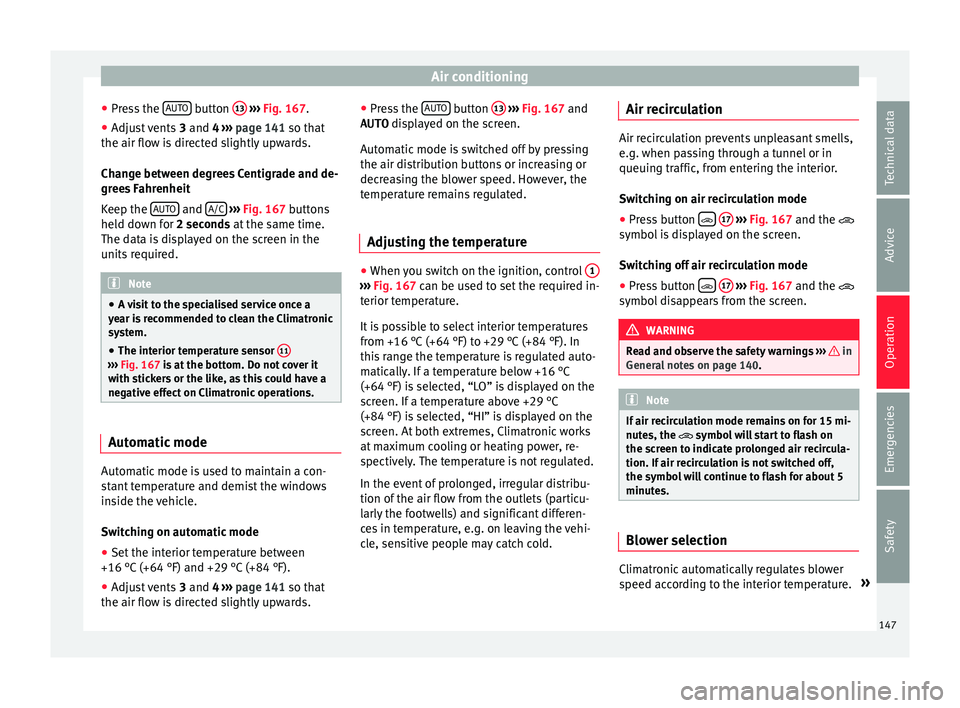
Air conditioning
● Pr e
ss
the AUTO button
13
› ››
Fig. 167
.
● Adju s
t vents 3 and 4 ››› p
age 141 so that
the air flow is directed slightly upwards.
Change between degrees Centigrade and de-
grees Fahrenheit
Keep the AUTO and
A/C
› ››
Fig. 167
butt
ons
held down for 2 seconds at the same time.
The data is displayed on the screen in the
units required. Note
● A vi s
it to the specialised service once a
year is recommended to clean the Climatronic
system.
● The interior temperature sensor 11›››
Fig. 167 is at the bott
om. Do not cover it
with stickers or the like, as this could have a
negative effect on Climatronic operations. Automatic mode
Automatic mode is used to maintain a con-
s
t
ant t
emperature and demist the windows
inside the vehicle.
Switching on automatic mode
● Set the interior temperature between
+16 °C (+64 °F) and +29 °C (+84
°F).
● Adjust vents 3 and 4 ›››
p
age 141 so that
the air flow is directed slightly upwards. ●
Press
the AUTO button
13
› ››
Fig. 167
and
AUTO dis
played on the screen.
Automatic mode is switched off by pressing
the air distribution buttons or increasing or
decreasing the blower speed. However, the
temperature remains regulated.
Adjusting the temperature ●
When you switch on the ignition, control 1 ›››
Fig. 167 can be used t o set
the required in-
terior temperature.
It is possible to select interior temperatures
from +16 °C (+64 °F) to +29 °C (+84 °F). In
this range the temperature is regulated auto-
matically. If a temperature below +16 °C
(+64 °F) is selected, “LO” is displayed on the
screen. If a temperature above +29 °C
(+84 °F) is selected, “HI” is displayed on the
screen. At both extremes, Climatronic works
at maximum cooling or heating power, re-
spectively. The temperature is not regulated.
In the event of prolonged, irregular distribu-
tion of the air flow from the outlets (particu-
larly the footwells) and significant differen-
ces in temperature, e.g. on leaving the vehi-
cle, sensitive people may catch cold. Air recirculation Air recirculation prevents unpleasant smells,
e.g. when pa
s
sing through a tunnel or in
queuing traffic, from entering the interior.
Switching on air recirculation mode
● Press button
17
››› Fig. 167 and the
symbo
l is displayed on the screen.
Switching off air recirculation mode
● Press button
17
› ›
› Fig. 167 and the
symbol disappears from the screen. WARNING
Read and observe the safety warnings ››› in
General not
es on page 140. Note
If air recirculation mode remains on for 15 mi-
nutes, the
symbol will start to flash on
the screen to indicate prolonged air recircula-
tion. If air recirculation is not switched off,
the symbol will continue to flash for about 5
minutes. Blower selection
Climatronic automatically regulates blower
s
peed ac
cor
ding to the interior temperature. »
147
Technical data
Advice
Operation
Emergencies
Safety
Page 150 of 252
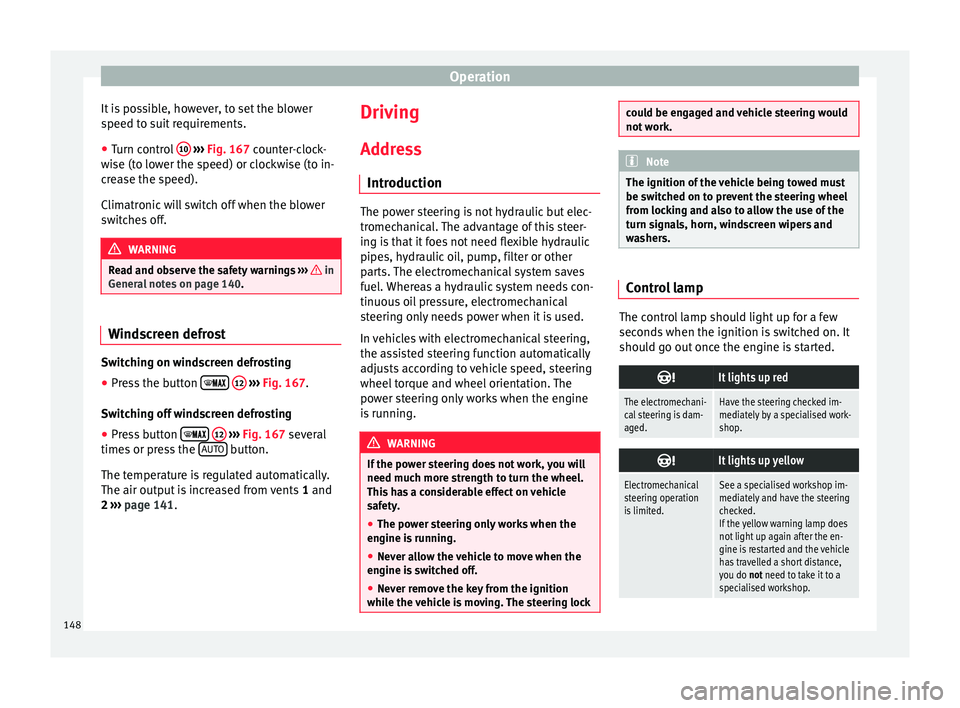
Operation
It is possible, however, to set the blower
s peed t
o suit
requirements.
● Turn control 10
› ››
Fig. 167
cou
nter-clock-
wise (to lower the speed) or clockwise (to in-
crease the speed).
Climatronic will switch off when the blower
switches off. WARNING
Read and observe the safety warnings ››› in
General not
es on page 140. Windscreen defrost
Switching on windscreen defrosting
●
Press the button
12
› ›
›
Fig. 167
.
Switching off windscreen defrosting
● Press button
12
› ›
›
Fig. 167
several
times or press the AUTO button.
The t emper
atur
e is regulated automatically.
The air output is increased from vents 1 and
2 ›››
page 141. Driving
Ad dr
es
s
Introduction The power steering is not hydraulic but elec-
tromech
anic
al. The advantage of this steer-
ing is that it foes not need flexible hydraulic
pipes, hydraulic oil, pump, filter or other
parts. The electromechanical system saves
fuel. Whereas a hydraulic system needs con-
tinuous oil pressure, electromechanical
steering only needs power when it is used.
In vehicles with electromechanical steering,
the assisted steering function automatically
adjusts according to vehicle speed, steering
wheel torque and wheel orientation. The
power steering only works when the engine
is running. WARNING
If the power steering does not work, you will
need much more s tr
ength to turn the wheel.
This has a considerable effect on vehicle
safety.
● The power steering only works when the
engine is ru
nning.
● Never allow the vehicle to move when the
engine is sw
itched off.
● Never remove the key from the ignition
while the v
ehicle is moving. The steering lock could be engaged and vehicle steering would
not work.
Note
The ignition of the vehicle being towed must
be sw itched on t
o prevent the steering wheel
from locking and also to allow the use of the
turn signals, horn, windscreen wipers and
washers. Control lamp
The control lamp should light up for a few
sec
ond
s when the ignition i
s switched on. It
should go out once the engine is started.
It lights up red
The electromechani-
cal steering is dam-
aged.Have the steering checked im-
mediately by a specialised work-
shop.
It lights up yellow
Electromechanical
steering operation
is limited.See a specialised workshop im-
mediately and have the steering
checked.
If the yellow warning lamp does
not light up again after the en-
gine is restarted and the vehicle
has travelled a short distance,
you do not need to take it to a
specialised workshop. 148